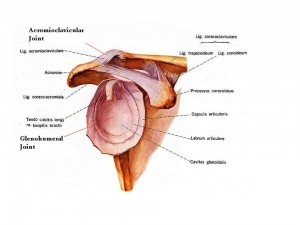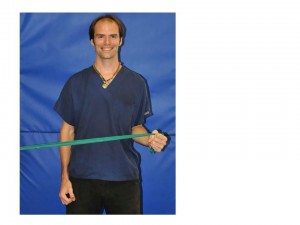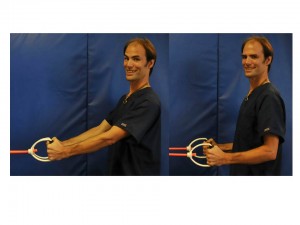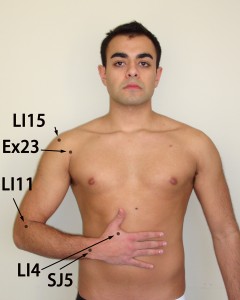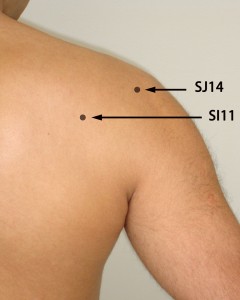News Letter, Vol. 4 (2), Februrary , 2012, © Copyright
Jun Xu, M.D. Lic. Acup., Hong Su, C.M.D., Lic. Acup.
Robert Blizzard III, DPT
Rehabilitation Medicine and Acupuncture Center
1171 East Putnam Avenue, Building 1, 2nd Floor
Greenwich, CT 06878
Tel: (203) 637-7720
Fax: (203)637-2693
Shoulder Arthritis
www.drdavidduckworth.com.au
Brittany, a sixty-five-year-old woman, experienced on-and-off pain in her shoulder for two or three years, especially upon awakening. The pain was located on the front, sometimes the top, of her shoulder, which made everyday tasks, such as reaching for a high shelf or combing her hair, difficult for her. It also caused swelling of her right shoulder, which became worse when the weather changed, so much so that she told her friends she was a human weathervane. Recently, she began to feel a clicking or grinding sound in the shoulder, and it became increasingly difficult to fall or stay asleep due the pain, which has been increasing for several years.
Brittany was a basketball player in college and sometimes when she shot the ball she felt some pain, but it went away after a day or two. She began taking Tylenol and Advil, which gave some relief, but because she was so occupied with her own business, and because she always assumed the pain would eventually go away, she never made the time to go to a doctor before she came to me.
In my physical exam, I found the deltoid muscle of her right shoulder was atrophied. The right shoulder front, top, and back of the shoulder blade were all tender. When I performed a range of motion test, the flexing in the right shoulder was about 0–120 degrees and her extension was about 0–115 degrees, with pain in the 0–70 degree extension. The grinding, cracking noise that accompanied this extension made the pain in this shoulder feel worse, but I found no signs of arthritis in other joints, including the left shoulder, which was perfectly normal.
Symptoms, Causes, and Diagnosis
There are two main shoulder joints
The glenohumeral joint, which is also called the bone-circuit joint. Here, the typical pain is on the top and back of the shoulder and it sometimes involves pain in the shoulder blade, the scapula, and restricted range of motion.
The acromioclavicular joint. Arthritis can develop where the collarbone meets the shoulder blade (scapula), at the bony prominence on the top of the shoulder blade known as the acromion. The pain is at the top of the shoulder and increases when, for example, the arm is crossed in front of the body to touch the other shoulder, or the arm is raised to comb the hair or take something from a high shelf.
Figure 2.1
There are three principal types of arthritis.
Osteoarthritis, inflammation of the joints, is caused by wear and tear.
Rheumatoid arthritis, an autoimmune disease that is usually a symmetrical inflammation of the joints, especially the shoulder, knee, and other small joints.
Posttraumatic arthritis, which results from injury.
Treatments for Shoulder Arthritis in Western Medicine
Noninvasive Treatments
The first methods to try are the nonsurgical treatments.
Rest
Rest and changing physical activities. The person should avoid any activity that provokes pain.
Compresses
Using hot and cold compresses can be very helpful.
Physical Therapy
Physical therapy and massages. Below are a few exercises that will help strengthen the rotator cuff to allow more fluid motion. Three sets of 10 each should be performed 3 times a week.
Figure 2.2
Figure 2.3
Surgery
If non-surgical treatments do not work, then surgery would be necessary.
Resection arthroplasty is the most common surgical procedure for arthritis of the acromioclavicular joint. Its purpose is to restore the flexible connection between the acromion and the collarbone. A small piece of bone from the end of the collarbone is removed, leaving a space that later fills in with scar tissue.
Total shoulder arthroplasty for glenohumeral joint arthritis. In this procedure, a surgeon replaces the entire shoulder joint with a prothesis.
Hemiarthroplasty, also for glenohumeral joint arthritis. In this procedure, the surgeon replaces the head of the upper arm bone. One joint surface is replaced with an artificial material, usually metal.
I suggest to most of my patients that they try the nonsurgical treatments first. However, if the pain is intolerable and severely restricts sleep, a surgical treatment might be the better of the two options.
Treatments for Shoulder Arthritis in Traditional Chinese Medicine
Acupuncture
When performed appropriately, acupuncture can help with these two types of osteoarthritis.
For glenohumeral osteoarthritis, I use Jian Yu, Jian Liao, Jian Zhen, Quchi He Gu, and also Tian Zhong and Jian Qian. All needles need to be inserted to about 1.5 inches with electrical stimulation for about 30 minutes. The patient must be in a seated position and the electrical stimulation should be as high as can be tolerated.
For acromioclavicular osteoarthritis, it is essential to locate the exact point of tenderness in the front of the shoulder and the AC joint and insert the needle into that AC joint, then the remaining points as in the preceding paragraph. This principle of treatment is called “acupuncture points selection based on the pain location,” aka the specific anatomical location following the pain points.
Table 2.1
| Points | Meridian/No. | Location | |
| 1 | Jian Qian | Extrapoints 23 | See Fig 2.4 |
| 2 | Jian Yu | LI 15 | See Fig 2.4 |
| 3 | Jian Zhen | SI 9 | See Fig 2.4 |
| 4 | Jian Liao | SJ 14 | See Fig 2.5 |
| 5 | Tian Zhong | SI 11 | See Fig 2.5 |
| 5 | Qu Chi | LI 11 | See Fig 2.4 |
| 7 | Wai Guan | SJ 5 | See Fig 2.4 |
| 8 | He Gu | LI 4 | See Fig 2.4 |
Fig 2.4
Fig 2.5
Brittany’s Treatment
Brittany had an X-ray which showed that the cartilage of her right shoulder was wearing out. On the glenohumeral joint there was a loss of joint space and bone spurs were present. She was also given a blood test to rule out rheumatoid arthritis, and it came back negative.
Brittany was advised to avoid lifting anything heavy, to stop using weights, or doing any other upper-extremity exercises, including basketball, if she still played that sport.
If her shoulder was swollen, Brittany was advised to use a cold pad for 15–20 minutes 3 times a day; conversely, if there was no swelling, then she was advised to use a heating pad in the same manner. Acupuncture, physical therapy, and massage were to be tried before any surgery was performed.
Brittany received treatment 3 times a week for 6–8 weeks and her shoulder pain was much relieved. However, I had to advise her that acupuncture cannot change the lost cartilage or remove the clicking, snapping sound. It could decrease the pain, making it improved enough that she would be able to get a good night’s sleep and could prolong the need for surgery. Brittany reported that this was indeed the case after the treatments. For now, her pain has sufficiently diminshed to allow her to go on living her life without having to resort to surgery. [Ed.Supplied an upbeat update that was needed here.].
Tips for People with Shoulder Osteoarthritis
- If your shoulder is a normal temperature, always put a heating pad on it twice a day for 30 minutes each time. If it is hot, place a cold pad there for the same amount of time.
- After the hot or cold pad, spend 30 minutes a day doing range-of-motion exercises for the shoulder. These will greatly improve your shoulder mobility and decrease the pain.


